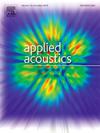基于vmd的声衰减系数理论计算及管道泄漏定位
IF 3.4
2区 物理与天体物理
Q1 ACOUSTICS
引用次数: 0
摘要
在目前基于声衰减特性的管道泄漏定位研究中,声衰减系数的计算通常需要收集实验泄漏信号,这会带来额外的经济和时间成本。针对这一问题,本文提出了一种基于变分模态分解(VMD)计算声衰减系数的理论方法:首先,基于Timoshenko梁理论建立阻尼管道振动方程,从理论上计算管道不同位置处的频响函数;然后利用VMD将泄漏信号分解成多个尺度。根据泄漏信号的峰值频率提取其主模态分量,并与频响函数相乘,计算管道各位置的振动响应能量。最后,采用线性拟合得到了声衰减系数的理论解。搭建管道泄漏定位实验平台,将声衰减系数的理论解代入定位公式进行测试。传统方法的平均定位误差为1.77%,在不同泄漏条件下,误差最大可达2.69%。相比之下,该方法的平均误差为1.51%,最大误差为1.56%。结果表明,本文提出的声衰减系数理论计算方法和泄漏定位方法具有较高的准确性和鲁棒性。该研究对于拓宽声衰减特性在泄漏定位场景中的应用具有重要意义。本文章由计算机程序翻译,如有差异,请以英文原文为准。
VMD-based theoretical calculation of the acoustic attenuation coefficient and pipeline leak localization
In the current research on pipeline leak localization based on acoustic attenuation characteristics, the calculation of the acoustic attenuation coefficient typically requires the collection of experimental leakage signals, which incurs additional economic and time costs. To address this issue, this paper proposes a theoretical method for calculating the acoustic attenuation coefficient based on Variational Mode Decomposition (VMD): First, a damped pipeline vibration equation is established based on the Timoshenko beam theory, and the frequency response function at different pipeline positions is calculated theoretically. The leakage signal is then decomposed into multiple scales using VMD. The main modal components of the leakage signal are extracted based on their peak frequencies and multiplied by the frequency response function to calculate the vibration response energy at various pipeline positions. Finally, a linear fitting is applied to obtain the theoretical solution for the acoustic attenuation coefficient. A pipeline leak localization experimental platform is constructed, and the theoretical solution for the acoustic attenuation coefficient is substituted into the localization formula for testing. The traditional method exhibits a mean localization error of 1.77%, increasing to a maximum of 2.69% under varying leakage conditions. In contrast, the proposed method achieves a mean error of 1.51%, with a maximum increase to 1.56%. These results demonstrate the superior accuracy and robustness of the theoretical calculation of the acoustic attenuation coefficient and the leakage localization method presented in this study. This study is significant for broadening the application of acoustic attenuation characteristics in leak localization scenarios.
求助全文
通过发布文献求助,成功后即可免费获取论文全文。
去求助
来源期刊

Applied Acoustics
物理-声学
CiteScore
7.40
自引率
11.80%
发文量
618
审稿时长
7.5 months
期刊介绍:
Since its launch in 1968, Applied Acoustics has been publishing high quality research papers providing state-of-the-art coverage of research findings for engineers and scientists involved in applications of acoustics in the widest sense.
Applied Acoustics looks not only at recent developments in the understanding of acoustics but also at ways of exploiting that understanding. The Journal aims to encourage the exchange of practical experience through publication and in so doing creates a fund of technological information that can be used for solving related problems. The presentation of information in graphical or tabular form is especially encouraged. If a report of a mathematical development is a necessary part of a paper it is important to ensure that it is there only as an integral part of a practical solution to a problem and is supported by data. Applied Acoustics encourages the exchange of practical experience in the following ways: • Complete Papers • Short Technical Notes • Review Articles; and thereby provides a wealth of technological information that can be used to solve related problems.
Manuscripts that address all fields of applications of acoustics ranging from medicine and NDT to the environment and buildings are welcome.
 求助内容:
求助内容: 应助结果提醒方式:
应助结果提醒方式:


